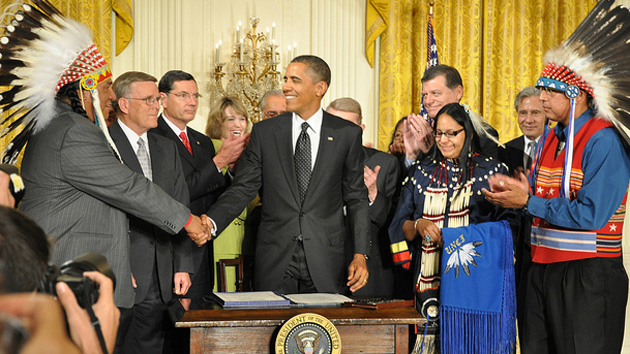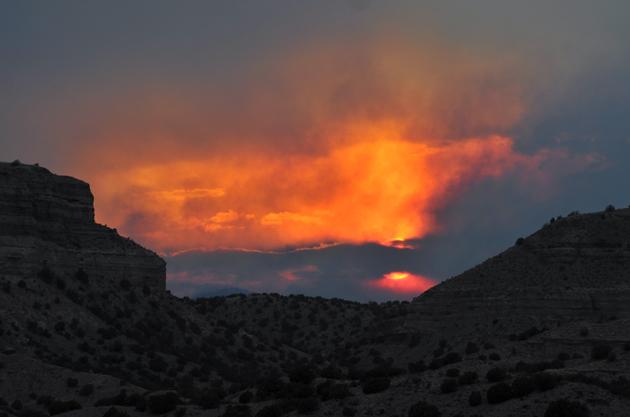
President Obama signing the Tribal Law and Order Act in 2010.<a href="https://www.flickr.com/photos/ncai/4841669793/in/set-72157624487358173">National Congress of American Indians</a>/Flickr
This Friday, President Obama will step on American Indian land for his first time as president. He’ll be visiting the Standing Rock Sioux Reservation, which straddles one million acres of the Dakota plains, to meet with leaders and discuss issues facing American Indians. The last sitting president to visit reservation land was Bill Clinton in 1999, so this week’s visit is a big deal.
In a June 5 op-ed in Indian Country Today, the president promised to do more for American Indians. But he also argued that his administration has already delivered great progress. Is that the case?
When Obama visits Standing Rock, he will find a community where 86 percent of residents are unemployed. That’s only the sixth–worst unemployment rate among Indian reservations: the worst is 93 percent, at the Sokaogo Chippewa Community in Wisconsin.
On top of unemployment, the American Indian community faces a number of other challenges: sky-high rates of adolescent suicide, rape, obesity, alcoholism, drug use, physical abuse and even post–traumatic stress disorder.
On the eve of this presidential visit, here’s a rundown of what the Obama Administration has done to tackle some of the problems faced by the American Indian community:
- Obesity: Childhood obesity is twice as common among American Indians than any other group. “Let’s Move in Indian Country,” a targeted version of Michelle Obama’s national program against childhood obesity, was introduced in 2011 to address the problem.
- Sexual Assault/Violent Crime: Violent crime rates on reservations are two and a half times the national average, putting them on par with crime-heavy cities like Detroit. Violence against women is also staggeringly high: One in three American Indian women will be raped in her lifetime, and American Indian women are ten times more likely to be murdered than the general population. In efforts to deter such crimes, Obama signed the Tribal Law and Order Act (TLOA) in 2010 to expand the authority and resources of tribal law enforcement agencies. Against Republican opposition, he also re-authorized the Violence Against Women Act in 2013 with specific provisions for tribal authorities. (Had the GOP’s version of VAWA prevailed, it would’ve made prosecuting sexual assault on reservations harder.) Obama’s re–authorization gave tribal law enforcement the grounds to prosecute non–American Indians, who commit up to 86 percent of sexual assaults against American Indian women.
- Education: American Indian schools and students lag behind national averages in most key indicators. In 2010, American Indians were the only group to see a drop in high school graduation rates. For Black, Latino and White students, graduation rates rose. The disparity extends to college: In 2010, 37 percent of American Indian males had completed an undergraduate degree within six years, compared to 59 percent of white males. In December 2011, Obama launched the White House Initiative on American Indian and Alaska Native Education to “expand education opportunities” for American Indian students by boosting recruitment of good teachers and supporting development of tribal colleges and universities.
But these administration efforts don’t seem to have made much of a dent:
- The national obesity rate among children aged two to five is down by 43 percent. But that drop isn’t reflected in the American Indian community, where rates of extreme obesity haven’t budged.
- Reservation crime remained high even after the passage of the TLOA, so the administration decided to try sending in “surges” of law enforcement, a strategy that worked in the Iraq war. Results were mixed: crime went down on three of the four high–crime reservations targeted, but one, a Wyoming reservation, reported that crime rates were up 7 percent. A federal report from November 2013 also found that reservations remain “dramatically more dangerous” than the rest of the country.
- In South Dakota, where American Indians are the state’s largest minority, only 49 percent of American Indian students graduated high school in 2013. The state’s average graduation rate that year was 81.8 percent. Test scores indicate they lag far behind white students—only 42 percent of American Indian students scored “proficient” or higher on state math exams, compared to 80 percent of white students. With sequestration threatening to cut funding for reservation schools, the state of American Indian education may get even worse.
As he gears up for his historic visit, Obama is sure to be aware of the extent of Indian Country’s challenges. If he wants to solve them, this first trip shouldn’t be his last.














